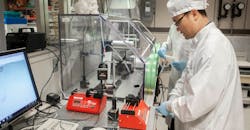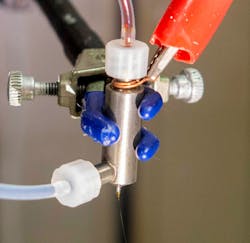Coaxial E-Spun Fibers Open the Door to New Drug Delivery Channels
A research team at the University of Cincinnati has developed a process it calls coaxial electrospinning, which combines two or more materials into a fine fiber for use in medicine or industry. It uses a machine that pumps two or more liquid polymers through a special nozzle where an electric voltage is applied. This turns the materials into a fine fiber consisting of a core made of one of the polymers and a sheath or jacket made of the other. The resulting fiber shares properties of both polymers.
Electrospinning was first invented in 1902 and was eventually applied to textiles in the 1930s, but only now are researchers realizing its full potential. “The beauty is you can have combinations of polymers with properties you don’t normally find in nature,” says Andrew Steckl, team leader. For example, researchers can combine a stiff core surrounded by soft, flexible, or adhesive material.
There are also potential applications in healthcare, including drug delivery, that are being investigated. For example, drug companies could put drug molecules on the inside of a coax fiber for a treatment surrounded by pain-relief molecules on the outside.
A thin fiber shoots from this nozzle in a jet of liquid during the electrospinning process. (Courtesy: Joseph Fuqua II/UC Creative Services)
So far, Steckl says, animal trials have shown that e-spun coax fibers provide even better results because surgeons can apply different combinations of treatments that deliver medicine for the desired duration.
“Dr. Steckl’s unique electrospun formulation are appealing to us for several reasons,” says Betty Tyler, manager of the Hunterian Neurosurgical Lab. She is pioneering a treatment in which a lesion is removed and a coaxial electrospun capsule is applied to administer the medicine locally over days or weeks.
“The electrospun capsule can slowly release its payload, it’s biocompatible, and several drugs can be loaded and released from it.”
Tyler says she plans to apply electrospinning to other FDA-approved drugs in unique combinations for treating brain tumors. “Our hope is to deliver these agents using Dr. Steckl’s technology to ultimately increase therapeutic options for patients with brain tumors,” Tyler says.
Steckl point out that the fibers’ large surface area and custom properties make them well-suited for drug delivery. For example, patients with Parkinson’s and other diseases often have to take drugs several times per day. A single long-acting dose delivered on electrospun fiber would make it easier for patients who might forget to take the proper dosage over the course of the day.
Medical researchers are also investigating fibers that only dissolve when the acidity level in the digestive system is at a specific level. This could delay or extend the release of active ingredients.
To wit, Steckl and his UC team are looking into inventing a new form of contraception in which the electrospun fiber would be used to make a tampon-like application that traps and kills sperm. Another version could release anti-infective drugs to prevent sexually transmitted diseases. The devices could be easier to use and more effective than sponge-type contraceptives. Results so far have led to the National Institutes of Health approving funding for a five-year study.
One drawback to the process has been turning out enough fibers for commercial use. But dozens of companies in the U.S. and globally are developing large-scale production equipment for coaxial electrospun fibers.


